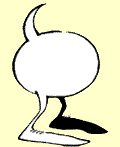|
Respuestas a: MANUEL BARRERO
1.- I disagree. The field today is filled with great talent. Innovation
today is built around ideas, not so much on draftsmanship.
2. - Today we are all working on the shoulders of the great pulp
magazine illustrators and the early cartoonists. Personally, I still am
strongly influenced by George Herriman's skills with narrative graphics.
3. - In THE SPIRIT, I tried to combine expressive cartooning with
realistic draftsmanship. Cartoons have the capacity of engaging the
reader emotionally.
4. - McCay's skills were almost operative. His ability to render
architecture was overwhelming. He came from circus posters.
5. - My intention or "presumption" was always to depict people in the
process of living - or life.
6. - The "graphic novel" title was intended only to describe the nature
of the package. It only influences the content by allowing the author
freedom of length to develop a more complex story. For me it meant a
presumption of a "classic" structure of a literary work.
7. - In graphic literature (comics) the artwork is most prominent. It
tends to dominate the reader's attention in the beginning. As a result,
during the creation of this form of literature, there is a "struggle for
integrity" between the author and the artist - even if they are same
person. Unfortunately, artwork, too often, dominates.
8. - Sequential art following the western reading convention. I do not
compose (or plan) a page. My page layouts are a result of the narrative
sequence.
9. - In my case, nothing in my work is accidental. I start with the end
of the story and work my way up to it reasoning the sequence of events
all the way to the end
10. - Comics have historically suffered from a prejudice by adult
readers and literary critics who regarded the medium as infantile. That
is changing as content is maturing and the need for imagery to provide
more rapid communication is advancing.
11. - All my work deals with "the comedy of life." In my view, the enemy
is life itself. Trying to prevail is the essence of the struggle.
SANTI GIRON
12. – No. Life today operates at a different rhythm so an author must
communicate in the visual language of our times.
13. – The current market of comics is more receptive to mature material.
There are more publishers than ever before. There are most distributors
and shops than ever before. The quality of material is better than ever
before.
14. - Comics have a great future because they all respond to the need
for more rapid communication than text alone.
15. – Video has not killed movies. Movies did not kill live theater.
Radio did not kill records. Computers have not killed print.
16. – THE SPIRIT has been licensed to a producer and probably will be a
film one day soon.
17. – I hope they will make a film that has some depth of character. I
have forbidden the alteration of the "character of THE SPIRIT: so I
don't expect that he will be a superman.
18.- Yes. I'm at work on another instructional book having to do with
emotional anatomy.
19. – I cannot answer that question fairly or without hurting some
deserving artist I may overlook. There are so many brilliant creators in
the field
20. – It is a clever statement and it may be true but the graphic
narrative is a universal language and it is inaccurate to try to
characterize work on a national basis
PACO NAJERA
21.- I was from childhood very interested and intrigued by storytelling.
I was always driven by innovation because attempting new ideas or
concepts had the thrill of risk and adventure.
22.- Yes.
23.- That is probably because I've been here and working so long.
24.- Yes, I've just completed and I'm editing a new graphic novel that
is a polemic. It reveals the true story of the origin of one of the
world's most nefarious frauds, the "Protocols of Zion." It will be
published in May of 2005
25- The secret, I guess, is to keep working and do not look at the
calendar or the clock,
UBALDO BOYANO
1. My early years in comics were at the same time as the transition of
newspaper comic strips to comic magazines. It was a "frontier"
experience in which there was opportunity for invention
2. I use a sable brush (#2 or #3) and a quill pen for backgrounds and
hard materials like wood, concrete or steel. I used a Japanese brush.
Others used a sable brush and a pen.
3. The opportunity for experiment and new ideas.
4. The computer is a machine. It does not think or feel. It can deliver
a huge palette of color.
5. Read short stories and concentrated on learning the stagecraft of
visual narrative
|
